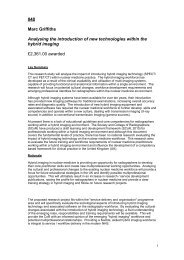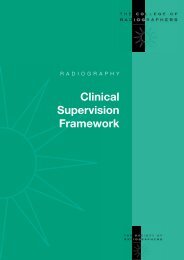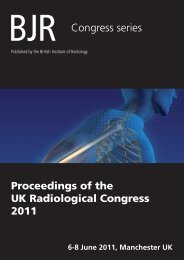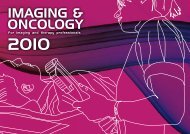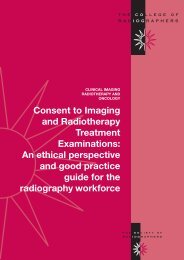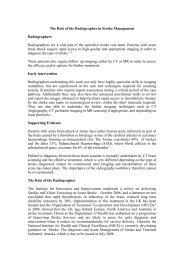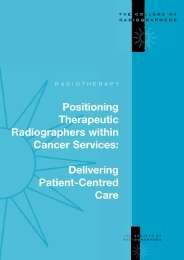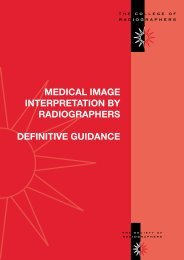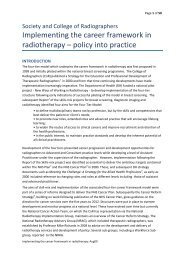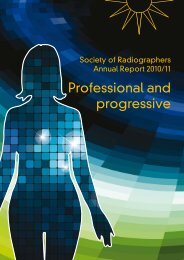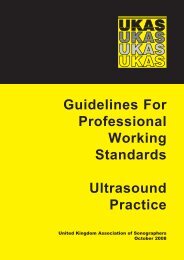SoR Brochure Child and Law SGG-82330 NEW - Society of ...
SoR Brochure Child and Law SGG-82330 NEW - Society of ...
SoR Brochure Child and Law SGG-82330 NEW - Society of ...
You also want an ePaper? Increase the reach of your titles
YUMPU automatically turns print PDFs into web optimized ePapers that Google loves.
5.12 The British <strong>Society</strong> <strong>of</strong> Paediatric Radiologists (BSPR) has produced guidelines in the form<strong>of</strong> st<strong>and</strong>ards for skeletal surveys in suspected NAI. These are available via their website 42 .The guidelines include technical st<strong>and</strong>ards for technique, procedural st<strong>and</strong>ards, targetsfor outcome <strong>and</strong> image protocols.5.13 The <strong>Society</strong> & College <strong>of</strong> Radiographers expects each department in the UK to draw upclear referral guidelines for NAI <strong>and</strong> that such guidelines be available <strong>and</strong> easilyaccessible by radiographers. Managers are advised to use the BSPR st<strong>and</strong>ards <strong>and</strong>guidelines as a starting point. It is a managerial responsibility for the development <strong>and</strong>publication <strong>of</strong> these departmental guidelines.5.14 Kleinman et al (2004) 44 in the USA <strong>and</strong> others in the UK [James et al (2003) 45 ; Offiah &Hall (2003) 46 ; Carty (2003) 47 ] have all noted that in hospitals imaging protocols forsuspected NAI vary considerably as does, even more importantly, the diagnostic quality<strong>of</strong> the images.5.15 Brown & Henwood (1997) warn that failure to follow protocols laid down by hospitals maycause any images produced to be inadmissible should the case be heard in a court <strong>of</strong>law 20 .5.16 A so called “Babygram” (imaging that encompasses the whole child on 1 or 2radiographic exposures) plays no role in the imaging <strong>of</strong> children as it does not provide therequisite information about the specific <strong>and</strong> subtle abnormalities in cases <strong>of</strong> suspectedabuse. [Carty identifies that the total effective dose from a BSPR recommended survey is0.22mSv for a maximum <strong>of</strong> 22 exposures 47 ].5.17 The balance <strong>of</strong> the importance between retaining acceptable diagnostic image quality,whilst at the same time keeping the dose as low as reasonably practicable must beconsidered by the radiographer. It is preferable that a set <strong>of</strong> good quality images beproduced through the administration <strong>of</strong> a sufficient dose <strong>of</strong> radiation than the diagnosisbe uncertain <strong>and</strong> the child returned to a high risk environment.5.18 Doses must be within published diagnostic reference levels (DRLs) for children but dosereduction must not be at the expense <strong>of</strong> providing incontrovertible evidence <strong>of</strong> childabuse. The radiographer should record the exposure settings making a clinical evaluation<strong>of</strong> the outcome <strong>of</strong> the exposures.5.19 The BSPR recommend that computed radiography (CR) or direct digital radiographysystems may used provided that dedicated paediatric s<strong>of</strong>tware is available 42 .5.20 The <strong>Society</strong> & College <strong>of</strong> Radiographers recommends that hard copies be created at thesame time as those <strong>of</strong> digitally stored images. This will help prevent the possibility <strong>of</strong> thecreation <strong>of</strong> manipulated images being used in evidence. The valid images will then be thehard copy images which must be authenticated in the normal way 43 .16





